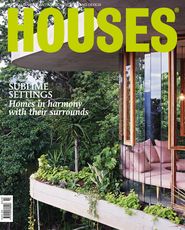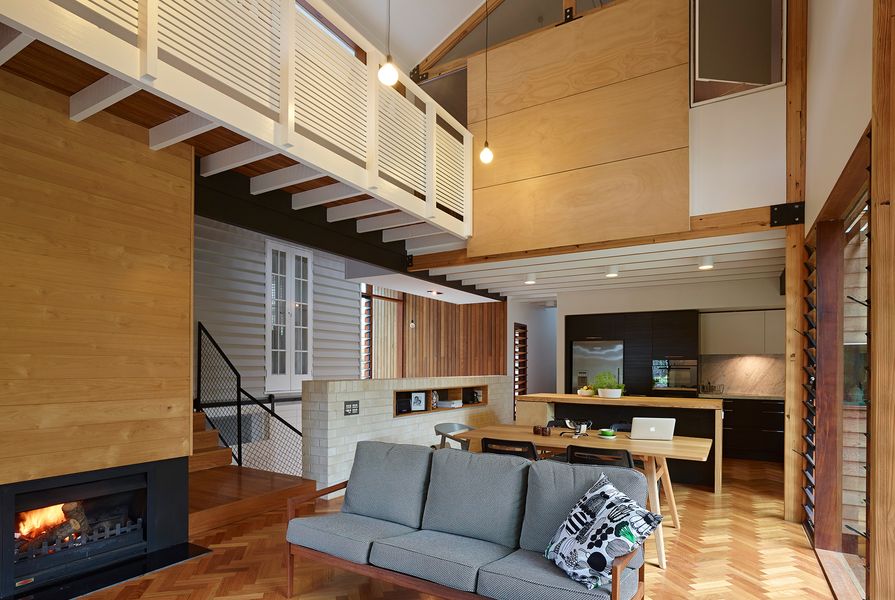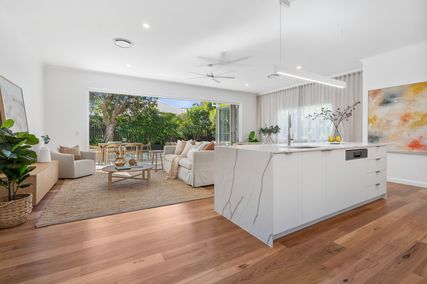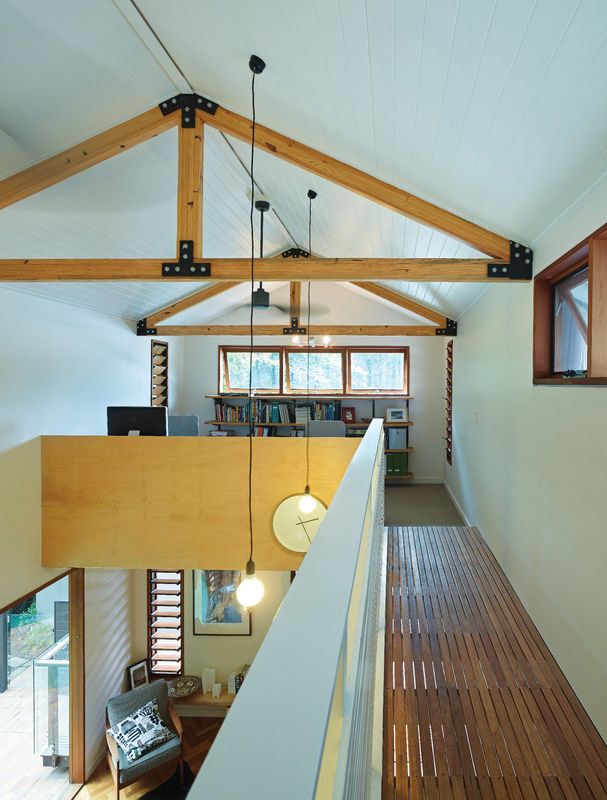The humble, tin-roofed cottage – with verandah and stumps, a weatherboard skin and tongue-and-groove linings – epitomizes Brisbane’s suburban vernacular. The native hoop pine, a colossal species surviving in scattered stands, is a monument to Brisbane’s once dense, subtropical landscape. Together, the cottage and pine tree, whose silhouetted form traces the ridges and gullies of the city’s hilly slopes, have shaped its colloquial identity.
In the Brisbane suburb of Ashgrove, the pairing of two such relics tells the story of a humble cottage, constructed in the 1920s to accommodate local timber workers, and a single magnificent hoop pine that predates the home and casts it in welcome shade. Their coexistence on this site was a drawcard for owner and architect Brad Muller of DM2 Architecture when he acquired the property some years ago. Now the two are anchors for a new addition in the form of a timber pavilion in the back garden.
The new pavilion, Brad says, was a contextual response acknowledging the vernacular traditions of the cottage and neighbourhood as well as the historical significance of the hoop pine. The architectural opportunities that these suggested – in terms of scale, form, materiality, structure and sustainability – have all served to influence the final scheme. Physical site constraints included an existing backyard pool, local creek flooding events and prescribed building edges and floor levels.
The vernacular traditions of the cottage and neighbourhood are acknowledged in the design of the new pavilion out the back.
Image: Scott Burrows
Hovering over the edge of the existing pool and brushing the lowest radial branches of the hoop pine, the two-storey gabled box clips directly to the back of the old cottage. Opposing the typically square, cellular plan of the old, the new extension is long and lean, approximately 4.5 metres wide and twelve metres long. The space is designed as the new family hub, accommodating social spaces downstairs and an upstairs bedroom and study for Brad and his wife Janet, allowing the cottage to remain as a dormitory for their grown-up children.
A new address was made by means of a pathway between the original house and the hoop pine, with the front door positioned beside the base of the broad trunk. The entrance is a grounded, brick-floored and walled vestibule that cuts a rectangular void encapsulating foyer, staircase and landing. Translucent roof sheeting and timber ceiling battens define this interstitial space, casting sunlight onto the now internalized rear facade of the weatherboard cottage. The vestibule merges and connects cottage and pavilion and announces immediate intentions for the orchestration of light and views, interior spatial dynamics and the tectonic quality of the architecture.
In contrast to the existing cottage, the extension is long and lean, and accommodates the new family hub.
Image: Scott Burrows
Inspiration for the structural and material expression of the addition came from vernacular traditions. Exposed laminated timber columns and roof trusses are a nod to the expressed framing typically found in traditional construction. An extensive and varied use of timber, in the form of parquetry floors, walls of both Western red cedar and pine, and white tongue-and-groove ceilings, supports the rich, tactile quality of the space and strengthens the dialogue between historic and contemporary. Spatial fluidity is ensured by the voluminous raked ceilings, urged on by the expansion and contraction of the single-height volumes of sitting room and kitchen that bookend the central, double-height space of the dining area.
The nearby pool and surrounding landscaping establish a serene backdrop to support an interior of dappled light and cooling breezes. Louvred and fixed glazing on the long back wall focuses attention directly out to the pool and garden, while more discreet openings maintain sight lines to distant vistas of blue and green. A corner encapsulated by frameless glass and reserved for the kitchen sink projects beyond the line of the pavilion to take in the garden at closer range. Such attention to the prospect from every corner of the pavilion is part of the pleasure of its experience.
Rainwater tanks, solar panels and passive ventilation systems contribute to the vastly improved environmental performance of the building. The permanently vented ridge of the pavilion establishes a system of convection, drawing cool air inside from the pool and the shady undercroft of the hoop pine to circulate before it is expelled vertically. The transparency of upstairs and downstairs ensures the effectiveness of this stack effect. Further edits inside the original cottage, making the old sleep-out part of the living space so as to funnel north-easterly breezes inside, also contribute to the passive cooling effect.
It is interesting to hear Brad denounce any intention to build his family a “dream home.” He says he was focused instead on responding in the best possible way to the unique opportunities presented by the site. While the cottage and pine tree seem the perfect foil for an addition content to recede into the romantic shadows of the past, humble intentions have spurred dramatic results that defy the expectations of compact living and fully embrace those favoured qualities of Brisbane’s character and climate.
Products and materials
- Roofing
- Lysaght Custom Orb and Trimdeck roof cladding; Ampelite Cool-Lite skylights.
- External walls
- Western red cedar in oil finish; Carter Holt Harvey Shadowclad grooved cladding in stain and paint finishes.
- Internal walls
- Western red cedar in oil finish; pine tongue-and-groove board in Whittle Waxes finish; VJ linings from Easycraft; plasterboard; face brick from CSR PGH Bricks and Pavers.
- Windows
- The Door Keeper timber window joinery in oil finish; Viridian green tint glass; ribbed glass; Western red cedar louvres.
- Doors
- The Door Keeper timber-framed glass doors; recycled items, painted.
- Flooring
- Boral parquetry and stringybark tongue-and-groove boards, both in Whittle Waxes finish.
- Lighting
- Recycled surface can fittings; custom pendants made in situ; Caribou Group downlights.
- Kitchen
- V-Zug appliances; Fisher and Paykel fridge; Carrara marble benchtop; island benchtop made from recycled ten pin bowling alley; plywood joinery made by client and from High Street Joinery.
- Bathroom
- Cygnat tapware, Mizu bath and Porcher toilet, all from Reece; Classic Ceramics mosaic tiles in pearl finish; Everstone floor tiles, honed.
- Heating and cooling
- Airfusion ceiling fans; Jetmaster fireplace; compressed fibre cement awnings.
- Other
- Recycled pavers; sandstone slabs; timber sleepers; timber decking, oiled.
Credits
- Project
- Ashgrove Residence
- Architect
- DM2 Architecture
Qld, Australia
- Project Team
- Brad Muller, Josh Graham
- Consultants
-
Engineer
Northrop Consulting Engineers
- Site Details
-
Location
Brisbane,
Qld,
Australia
Site type Suburban
Site area 550 m2
Building area 246 m2
- Project Details
-
Status
Built
Completion date 2014
Design, documentation 12 months
Construction 18 months
Category Residential
Type New houses
Source

Project
Published online: 27 Aug 2015
Words:
Michelle Bailey
Images:
Scott Burrows
Issue
Houses, June 2015

























